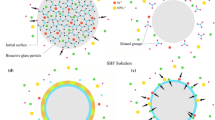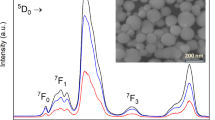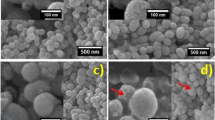Abstract
Calcium magnesium silicate glasses could be suggested for the synthesis of scaffolds for hard tissue regeneration, as they present a high residual glassy phase, high hardness values and hydroxyapatite-forming ability. The use of trace elements in the human body, such as Cu, could improve the biological performance of such glasses, as Cu is known to play a significant role in angiogenesis. Nano-bioceramics are preferable compared to their micro-scale counterparts, because of their increased surface area, which improves both mechanical properties and apatite-forming ability due to the increased nucleation sites provided, their high diffusion rates, reduced sintering time or temperature, and high mechanical properties. The aim of the present work was the evaluation of the effect of different ratios of Ethanol/TEOS and total amount of the inserted ammonia to the particle size, morphology and bioactive, hemolytic and antibacterial behavior of nanoparticles in the quaternary system SiO2–CaO–MgO–CuO. Different ratios of Ethanol/TEOS and ammonia amount affected the size and morphology of bioactive nanopowders. The optimum materials were synthesized with the highest ethanol/TEOS ratio and ammonia amount as verified by the enhanced apatite-forming ability and antibacterial and non-hemolytic properties.











Similar content being viewed by others
References
Lavallee DK, Sullivan JC, Deutsch E. Reaction of thiols with the one-equivalent oxidants neptunium(VI) and cerium(IV) in aqueous acidic media. Inorg Chem 1973;12:1440–2.
Luz GM, Mano JF. Preparation and characterization of bioactive glass nanoparticles prepared by sol-gel for biomedical applications. Nanotechnology 2011;22:494014.
Ghalia MA, Dahman Y. Advanced nanobiomaterials in tissue engineering: synthesis, properties, and applications. In: Grumezescu AM, editor. Nanobiomaterials in Soft Tissue Engineering. Applications of Nanobiomaterials Volume 5. Oxford: William Andrew; 2016. pp.141–172.
Ghorbanian L, Emadi R, Razavi M, Shin H, Teimouri A. Synthesis and characterization of novel nanodiopside bioceramic powder. JNS. 2012;3:357–61.
Zhang W, Shen Y, Pan H, Lin K, Liu X, Darvell BW, et al. Effects of strontium in modified biomaterials. Acta Biomater Acta Mater Inc. 2011;7:800–8. https://doi.org/10.1016/j.actbio.2010.08.031.
Kankilic B, Köse S, Korkusuz P, Timuçin M, Korkusuz F. Mesenchymal stem cells and nano-bioceramics for bone regeneration. Curr Stem Cell Res Ther. 2016;11:487–93.
Vrancken KC, Possemiers K, Van Der Voort P, Vansant EF. Surface modification of silica gels with aminoorganosilanes. Colloids Surf A Physicochem Eng Asp. 1995;98:235–41.
Composites HO, Series ACSS, Society AC. Hybrid organic-inorganic composites; 1995.
Cerveau G, Corriu RJP, Lepeytre C, Mutin PH. Influence of the nature of the organic precursor on the textural and chemical properties of silsesquioxane materials. J Mater Chem. 1998;8:2707–13.
Corriu R. A new trend in metal-alkoxide chemistry: the elaboration of monophasic organic-inorganic hybrid materials. Polyhedron. 1998;17:925–34.
Corriu RJP, Leclercq D. Recent developments of molecular chemistry for sol–gel processes. Angew Chem Int Ed Engl. 1996;35:1420–36. https://doi.org/10.1002/anie.199614201f.
Shea KJ, Loy DA, Webster O. Arylsilsesquioxane gels and related materials. New hybrids of organic and inorganic networks. J Am Chem Soc. 1992;114:6700–10.
Jackson CL, Bauer BJ, Nakatani AI, Barnes JD. Synthesis of hybrid organic−inorganic materials from interpenetrating polymer network chemistry. Chem Mater 1996;8:727–33.
Nassar EJ, Ciuffi KJ, Ribeiro SJL, Messaddeq Y. Europium incorporated in silica matrix obtained by sol-gel: luminescent materials. Mater Res 2003;6:557–62.
Beari F, Brand M, Jenkner P, Lehnert R, Metternich HJ, Monkiewicz J, et al. Organofunctional alkoxysilanes in dilute aqueous solution: new accounts on the dynamic structural mutability. J Organomet Chem. 2001;625:208–16.
Nassar EJ, Neri CR, Calefi PS, Serra OA. Functionalized silica synthesized by sol-gel process. J Non Cryst Solids. 1999;247:124–8.
Stober W, Fink A, Bohn E. Controlled growth of monodisperse silica spheres in the micron size range. J Colloid Interface Sci. 1968;26:62–9.
Papacídero AT, Rocha LA, Caetano BL, Molina E, Sacco HC, Nassar EJ, et al. Preparation and characterization of spherical silica-porphyrin catalysts obtained by the sol-gel methodology. Colloids Surf A Physicochem Eng Asp. 2006;275:27–35.
Nassar EJ, Nassor ECDO, Ávila LR, Pereira PFS, Cestari A, Luz LM, et al. Spherical hybrid silica particles modified by methacrylate groups. J Sol Gel Sci Technol. 2007;43:21–6.
Ricci GP, Rocha ZN, Nakagaki S, Castro KADF, Crotti AEM, Calefi PS, et al. Iron-alumina materials prepared by the non-hydrolytic sol-gel route: Synthesis, characterization and application in hydrocarbons oxidation using hydrogen peroxide as oxidant. Appl Catal A Gen. 2010;389:147–54. https://doi.org/10.1016/j.apcata.2010.09.011.
Matos MG, Pereira PFS, Calefi PS, Ciuffi KJ, Nassar EJ. Preparation of a GdCaAl3O7 matrix by the non-hydrolytic sol-gel route. J Lumin 2009;129:1120–4.
Castillo-León J, Andersen K, Svendsen W. Self–Assembled Peptide Nanostructures for Biomedical Applications: Advantages and Challenges. In: Pignatello R, editor. Biomterials Science and Engineering. Rijeka, InTech; 2011. pp.115–38.
Jafarzadeh M, Rahman IA, Sipaut CS. Synthesis of silica nanoparticles by modified sol-gel process: The effect of mixing modes of the reactants and drying techniques. J Sol Gel Sci Technol. 2009;50:328–36.
Hench LL, West JK. CH2-23-28 (sol-gel and base catalyst explain). Chem Rev 1990;90:33–72.
Chu L, Tejedor-Tejedor MI, Anderson MA. Particulate sol-gel route for microporous silica gels. Microporous Mater 1997;8:207–13.
Meixner DL, Dyer PN. Influence of sol-gel synthesis parameters on the microstructure of particulate silica xerogels. J Sol Gel Sci Technol. 1999;14:223–32.
Colomer MT, Anderson MA. High porosity silica xerogels prepared by a particulate sol-gel route: pore structure and proton conductivity. J Non Cryst Solids. 2001;290:93–104.
Enomoto N, Kumagai A, Hojo J. Aging effect of starting solutions for spherical silica synthesis. J Ceram Soc Japan. 2005;113:340–3.
Bogush GH, Zukoski CF. Uniform silica particle precipitation: an aggregative growth model. Chem Eng 1991;142:19–34.
Van Helden AK, Jansen JW, Vrij A. Preparation and characterization of spherical monodisperse silica dispersions in nonaqueous solvents. J Colloid Interface Sci. 1981;81:354–68.
Tan C, Bowen B, Epstein N. Production of monodisperse colloidal silica spheres: effect of temperature. J Colloid Interface Sci. 1987;118:290–3.
Enomoto N, Koyano T, Nakagawa ZE. Effect of ultrasound on synthesis of spherical silica. Ultrason Sonochem 1996;3:3–7.
Chen S, Dong P. The size dependence of growth rate of monodisperse silica particles from tetraalkoxysilane. J Colloid Interface Sci. 1997;272:268–72.
Sadasivan S, Rasmussen DH, Chen FP, Kannabiran RK. Preparation and characterization of ultrafine silica. Colloids Surf A Physicochem Eng Asp. 1998;132:45–52.
Lee K, Sathyagal AN, McCormick AV. A closer look at an aggregation model of the Stöber process. Colloids Surf A Physicochem Eng Asp. 1998;144:115–25.
Park SK, Kim KDo, Kim HT. Preparation of silica nanoparticles: determination of the optimal synthesis conditions for small and uniform particles. Colloids. Surf A Physicochem Eng Asp. 2002;197:7–17.
Green DL, Jayasundara S, Lam YF, Harris MT. Chemical reaction kinetics leading to the first Stober silica nanoparticles—NMR and SAXS investigation. J Noncryst Solids. 2003;315:166–79.
Green DL, Lin JS, Lam YF, Hu MZC, Schaefer DW, Harris MT. Size, volume fraction, and nucleation of Stober silica nanoparticles. J Colloid Interface Sci. 2003;266:346–58.
Nagao D, Osuzu H, Yamada A, Mine E, Kobayashi Y, Konno M. Particle formation in the hydrolysis of tetraethyl orthosilicate in pH buffer solution. J Colloid Interface Sci. 2004;279:143–9.
No YJ, Roohaniesfahani S, Lu Z, Shi J, Zreiqat H. Strontium-doped calcium silicate bioceramic with enhanced in vitro osteogenic properties. Biomed Mater 2017;12:035003.
Lin K, Xia L, Li H, Jiang X, Pan H, Xu Y, et al. Biomaterials enhanced osteoporotic bone regeneration by strontium-substituted calcium silicate bioactive ceramics. Biomaterials. 2013;34:10028–42.
Xu S, Lin K, Wang Z, Chang J, Wang L, Lu J, et al. Reconstruction of calvarial defect of rabbits using porous calcium silicate bioactive ceramics. Biomaterials. 2008;29:2588–96.
Wang C, Lin K, Chang J, Sun J. Osteogenesis and angiogenesis induced by porous β-CaSiO3/PDLGA composite scaffold via activation of AMPK/ERK1/2 and PI3K/Akt pathways. Biomaterials. 2013;34:64–77. https://doi.org/10.1016/j.biomaterials.2012.09.021.
Wang C, Xue Y, Lin K, Lu J, Chang J, Sun J. The enhancement of bone regeneration by a combination of osteoconductivity and osteostimulation using β-CaSiO3/β-Ca3(PO4)2 composite bioceramics. Acta Biomater. 2012;8:350–60. https://doi.org/10.1016/j.actbio.2011.08.019.
Zhu Y, Zhu M, He X, Zhang J, Tao C. Substitutions of strontium in mesoporous calcium silicate and their physicochemical and biological properties. Acta Biomater. 2013;9:6723–31. https://doi.org/10.1016/j.actbio.2013.01.021.
Zreiqat H, Ramaswamy Y, Wu C, Paschalidis A, Lu ZF, James B, et al. The incorporation of strontium and zinc into a calcium-silicon ceramic for bone tissue engineering. Biomaterials. 2010;31:3175–84. https://doi.org/10.1016/j.biomaterials.2010.01.024.
Ni GX, Shu B, Huang G, Lu WW, Pan HB. The effect of strontium incorporation into hydroxyapatites on their physical and biological properties. J Biomed Mater Res. 2012;100 B:562–8.
Ramaswamy Y, Wu C, Zhou H, Zreiqat H. Biological response of human bone cells to zinc-modified Ca-Si-based ceramics. Acta Biomater. 2008;4:1487–97.
Chen X, Ou J, Wei Y, Huang Z, Kang Y, Yin G. Effect of MgO contents on the mechanical properties and biological performances of bioceramics in the MgO-CaO-SiO2 system. J Mater Sci Mater Med. 2010;21:1463–71.
Wu C, Ramaswamy Y, Zreiqat H. Porous diopside (CaMgSi2O6) scaffold: a promising bioactive material for bone tissue engineering. Acta Biomater. 2010;6:2237–45.
Wu C, Ramaswamy Y, Soeparto A, Zreiqat H. Incorporation of titanium into calcium silicate improved their chemical stability and biological properties. J Biomed Mater Res. 2008;86:402–10.
Goudouri OM, Kontonasaki E, Chrissafis K, Zinn K, Hoppe A, Detsch R, et al. Towards the synthesis of an Mg-containing silicate glass-ceramic to be used as a scaffold for cementum/alveolar bone regeneration. Ceram Int. 2014;40:16287–98.
Diba M, Goudouri OM, Tapia F, Boccaccini AR. Magnesium-containing bioactive polycrystalline silicate-based ceramics and glass-ceramics for biomedical applications. Curr Opin Solid State Mater. 2014;18:147–67. https://doi.org/10.1016/j.cossms.2014.02.004.
Hoppe A, Meszaros R, Stähli C, Romeis S, Schmidt J, Peukert W, et al. In vitro reactivity of Cu doped 45S5 Bioglass® derived scaffolds for bone tissue engineering. J Mater Chem B 2013;1:5659.
Hoppe A, Güldal NS, Boccaccini AR. A review of the biological response to ionic dissolution products from bioactive glasses and glass-ceramics. Biomaterials. 2011;32:2757–74. https://doi.org/10.1016/j.biomaterials.2011.01.004.
Theodorou GS, Kontonasaki E, Theocharidou A, Bakopoulou A, Bousnaki M, Hadjichristou C, et al. Sol-gel derived Mg-based ceramic scaffolds doped with zinc or copper ions: preliminary results on their synthesis, characterization, and biocompatibility. Int J Biomater. 2016;2016:3858301.
Kaya S, Cresswell M, Boccaccini AR. Mesoporous silica-based bioactive glasses for antibiotic-free antibacterial applications. Mater Sci Eng C. 2018;83:99–107. https://doi.org/10.1016/j.msec.2017.11.003.
Skaug V, Gylseth B. Hemolytic activity of five different calcium silicates. Environ Health Perspect. 1983;51:195–203.
El-Kady AM, Farag MM. Bioactive glass nanoparticles as a new delivery system for sustained 5-fluorouracil release: characterization and evaluation of drug release mechanism. J Nanomater. 2015;2015:1–11.
Kokubo T, Kushitani H, Sakka S, Kitsugi T, Yamamum T. Surface-structure changes in bioactive. J Biomed Mater Res. 1990;24:721–34.
Zhang Y, Mizuno M, Yanagisawa M, Takadama H. Bioactive behaviors of porous apatite- and wollastonite-containing glass-ceramic in two kinds of simulated body fluid. J Mater Res. 2003;18:433–41.
Van Helden AK, Jansen JW, Vrij A. Preparation and Characterization of Spherical Monodisperse Silica Dispersions in Non- aqueous Solvents. J Colloid Interface Sci. 1981;81: 354–68.
Smith B. Infrared spectral interpretation: a system approach. CRC Press LLC; 2000.
Ogino M, Ohuchi F, Hench LL. Compositional dependence of the formation of calcium phosphate films on bioglass. J Biomed Mater Res. 1980;14:55–64.
Filgueiras MRT, La Torre G, Hench LL. Solution effects on the surface reactions of three bioactive glass compositions. J Biomed Mater Res. 1993;27:1485–93.
Zorba T, Kantiranis N, Papadopoulou L, Chrissafis K, Giannoulatou V, Zachariadis G, et al. Magnesium calcium silicate bioactive glass doped with copper ions; synthesis and in-vitro bioactivity characterization. J Noncryst Solids. 2018;500:98–109.
Shi J, Hedberg Y, Lundin M, Odnevall Wallinder I, Karlsson HL, Möller L. Hemolytic properties of synthetic nano- and porous silica particles: the effect of surface properties and the protection by the plasma corona. Acta Biomater 2012;8:3478–90.
Lei B, Chen X, Han X, Zhou J. Versatile fabrication of nanoscale sol-gel bioactive glass particles for efficient bone tissue regeneration. J Mater Chem. 2012;22:16906–13.
Kim KDo, Kim HT. Formation of silica nanoparticles by hydrolysis of TEOS using a mixed semi-batch/batch method. J Sol Gel Sci Technol. 2002;25:183–9.
Kim TG, An GS, Han JS, Hur JU, Park BG, Choi SC. Synthesis of size controlled spherical silica nanoparticles via sol-gel process within hydrophilic solvent. J Korean Ceram Soc. 2017;54:49–54.
Su M, Su H, Du B, Li X, Ren G, Wang S. Mesoporous silica with monodispersed pores synthesized from the controlled self-assembly of silica nanoparticles. Korean J Chem Eng. 2015;32:852–9.
Kankilic B, Bayramli E, Kilic E, Daǧdeviren S, Korkusuz F. Vancomycin containing PLLA/β-TCP controls MRSA in vitro. Clin Orthop Relat Res. 2011;469:3222–8.
Zeng D, Zhang H, Wang B, Sang K, Yang J. Effect of ammonia concentration on silica spheres morphology and solution hydroxyl concentration in stober process. J Nanosci Nanotechnol. 2015;15:7407–11.
Lukowiak A, Lao J, Lacroix J, Nedelec JM. Bioactive glass nanoparticles obtained through sol-gel chemistry. Chem Commun 2013;49:6620–2.
Mukundan LM, Nirmal R, Vaikkath D, Nair PD. A new synthesis route to high surface area sol gel bioactive glass through alcohol washing: a preliminary study. Biomatter 2013;3:1–10.
Bari A, Bloise N, Fiorilli S, Novajra G, Vallet-Regí M, Bruni G, et al. Copper-containing mesoporous bioactive glass nanoparticles as multifunctional agent for bone regeneration. Acta Biomater 2017;55:493–504.
Acknowledgements
The authors wish to thank the PhD Candidate L. Malletzidou for performing the XRD measurements and Dr T. Zorba for assistance on FTIR measurements.
Author information
Authors and Affiliations
Corresponding author
Ethics declarations
Conflict of interest
The authors declare that they have no conflict of interest.
Additional information
Publisher’s note: Springer Nature remains neutral with regard to jurisdictional claims in published maps and institutional affiliations.
Rights and permissions
About this article
Cite this article
Pouroutzidou, G.K., Theodorou, G.S., Kontonasaki, E. et al. Effect of ethanol/TEOS ratios and amount of ammonia on the properties of copper-doped calcium silicate nanoceramics. J Mater Sci: Mater Med 30, 98 (2019). https://doi.org/10.1007/s10856-019-6297-8
Received:
Accepted:
Published:
DOI: https://doi.org/10.1007/s10856-019-6297-8




